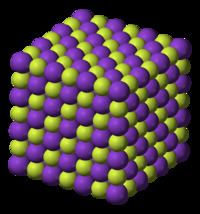Formula KF Melting point 858 °C Boiling point 1,505 °C | Molar mass 58.0967 g/mol Density 2.48 g/cm³ Appearance colourless | |
 | ||
Similar Potassium chloride, Potassium carbonate, Lithium fluoride | ||
Potassium fluoride
Potassium fluoride is the chemical compound with the formula KF. After hydrogen fluoride, KF is the primary source of the fluoride ion for applications in manufacturing and in chemistry. It is an alkali halide and occurs naturally as the rare mineral carobbiite. Solutions of KF will etch glass due to the formation of soluble fluorosilicates, although HF is more effective.
Contents
- Potassium fluoride
- This is how the ionic bond forms in potassium fluoride kf
- Preparation
- Applications in organic chemistry
- Safety considerations
- References
This is how the ionic bond forms in potassium fluoride kf
Preparation
Potassium fluoride is prepared by dissolving potassium carbonate in excess hydrofluoric acid. Evaporation of the solution forms crystals of potassium bifluoride. The bifluoride on heating yields potassium fluoride:
K2CO3 + 4HF → 2KHF2 + CO2↑ + H2OKHF2 → KF + HF↑The salt must not be prepared in glass or porcelain vessels as HF and the aqueous solution of KF corrode glass and porcelain. Heat resistant plastic or platinum containers may be used.
Applications in organic chemistry
In organic chemistry, KF can be used for the conversion of chlorocarbons into fluorocarbons, via the Finkelstein reaction. Such reactions usually employ polar solvents such as dimethyl formamide, ethylene glycol, and dimethyl sulfoxide.
Safety considerations
Like other sources of the fluoride ion, F−, KF is poisonous, although lethal doses approach gram levels for humans. It is harmful by inhalation and ingestion. It is highly corrosive, and skin contact may cause severe burns.
